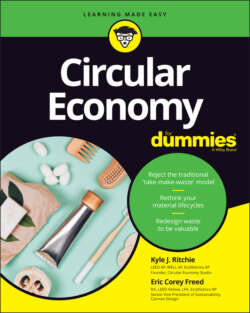Читать книгу Circular Economy For Dummies - Eric Corey Freed - Страница 28
Rethinking Material Lifecycles
ОглавлениеOnce you identify zero waste as a real possibility for the future, you need to make a number of adjustments to all areas of a material’s lifecycle — the various steps that take place during its sourcing, use, and recovery. To understand what opportunities are available to create a waste-free future, you first need to analyze where current lifecycles stand and where waste is generated. From there, you can incorporate conservation methods, efficient use, and proper regeneration of materials as part of your product lifecycle.
Current lifecycles rely on a linear processing of materials. Here, materials are extracted from the environment, made into products, and later sent to landfills or incinerated when the product no longer serves a function. This lack of proper management causes valuable resources to be lost forever and further drives the need to extract new and raw materials from the environment. It’s so unnecessary to throw things away, because every material — if properly managed — can be recaptured and applied to serve another purpose.
Though different materials require different management strategies, the opportunities are not only available but also clear. Whether it’s developing a community sharing network, localized repair centers, or a dedicated community workspace to upcycle or downcycle faulty products, the opportunities to eliminate waste are available if members of the global economy take the time to rethink how to manage material lifecycles.
